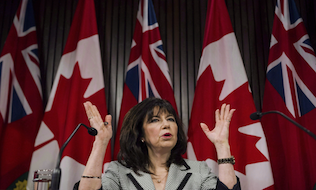
The Ontario government may be spending more than it needs to on generic drugs, according to the auditor general’s latest annual report.
Auditor general Bonnie Lysyk tabled her 2017 annual report on Wednesday, which found the province doesn’t know whether it’s making any progress in fighting preventable chronic disease.
It found total spending by Ontario’s public drug programs in 2016/17 was $5.9 billion before rebates. Brand-name medications made up about two-thirds of that total, while generic drug costs accounted for the remainder. However, generic drugs represented about two-thirds of total claims, according to the report.
Read: What’s the landscape for private benefits plans around generic drug prices?
Lysyk noted that the Ministry of Health and Long-Term Care had done a good job of reducing the costs of brand-name drugs by negotiating rebates from drug manufacturers. “However, pricing information on brand-name drugs around the world is confidential, so it is difficult to know whether the ministry is obtaining the best possible value compared to other jurisdictions,” she wrote.
The report found that while generic drug prices had declined in the past decade, Ontario still pays more than some other countries. For example, in 2015/16, Ontario paid about $100 million more for the same drugs as New Zealand. “Generic drug prices in Ontario have dropped significantly in the last 10 years, but opportunities appear to still exist for the ministry to obtain further discounts on generic drugs,” wrote Lysyk.
Read: The impact of Ontario’s public drug program changes on private plans
Also, Ontario doesn’t know whether its 26 public health units are making progress in the fight against preventable chronic disease, according to the report, which goes further to say the province doesn’t have any overarching prevention strategy to guide overall program planning and development.
While the audit found the ministry had made some progress in reducing smoking rates, it noted the need for more work to address other risk factors, such as physical inactivity, poor eating and heavy drinking. A separate report published by Ontario-based Institute for Clinical Evaluation Sciences in 2016 found that those four modifiable risk factors that contribute to chronic disease cost Ontario almost $90 billion in health-care costs between 2004 and 2013.
“The province spends an average of $1 billion a year on public health, including about $190 million on preventing chronic diseases, but it does not measure the performance of public health units in this area,” said Lysyk. “As a result, we don’t really know how effective the units have been in this area.”
The report found that current provincial performance indicators don’t fully measure public health units’ track record in preventing chronic disease and promoting better health. In fact, some units didn’t perform program evaluations to determine whether the programs had had a positive impact.
Read: Focus on preventative measures in fight against chronic disease
In her report, Lysyk also raised the issue of coverage for cancer drugs, Ontario covers the full cost of cancer drugs administered in a hospital, whereas British Columbia, Alberta, Saskatchewan and Manitoba provide coverage for all patients, regardless of where they take the medication, Lysyk noted.
Lysyk’s focus on Ontario’s public drug programs comes as the Canadian Pharmacists Association has proposed a plan to reform drug coverage in Canada. The organization is calling for a new national health accord to address universal drug coverage. Elements of its proposal include providing full drug coverage for all Canadians and developing a minimum national drug formulary. The organization is also calling on governments to harmonize catastrophic drug coverage.
The proposal suggests requiring all provinces to ensure all uninsured residents have access to public or private drug coverage for routine expenses, with the federal government introducing a new funding transfer to cover catastrophic costs. The provinces, in turn, would have to limit annual out-of-pocket costs to three per cent of household income.
